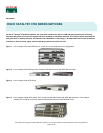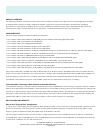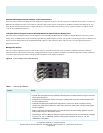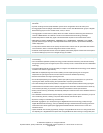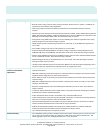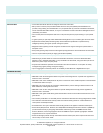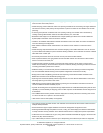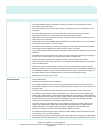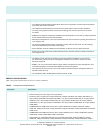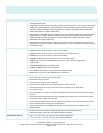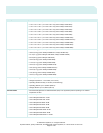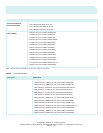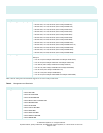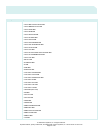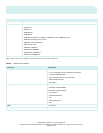
© 2005 Cisco Systems, Inc. All rights reserved.
Important notices, privacy statements, and trademarks of Cisco Systems, Inc. can be found on cisco.com.
Page 5 of 25
Feature
Benefit
• Autonegotiating on all ports automatically selects half- or full-duplex transmission mode to optimize
bandwidth.
• Dynamic Trunking Protocol (DTP) facilitates dynamic trunk configuration across all switch ports.
• Port Aggregation Protocol (PAgP) automates the creation of Cisco Fast EtherChannel
®
groups or Gigabit
EtherChannel groups to link to another switch, router, or server.
• Link Aggregation Control Protocol (LACP) allows the creation of Ethernet channeling with devices that
conform to IEEE 802.3ad. This feature is similar to Cisco EtherChannel technology and PAgP.
• DHCP Relay allows a DHCP relay agent to broadcast DHCP requests to the network DHCP server.
• IEEE 802.3z-compliant 1000BASE-SX, 1000BASE-LX/LH, 1000BASE-ZX, 1000BASE-T, and CWDM
physical-interface support through a field-replaceable SFP module provides unprecedented flexibility in
switch deployment.
• To help ensure that the switch can be quickly connected to the network and can pass traffic with minimal
user intervention, there is a default configuration stored in Flash memory.
• Automatic media-dependent interface crossover (MDIX) automatically adjusts transmit and receive pairs if
an incorrect cable type (cross-over or straight-through) is installed.
AVAILABILITY AND SCALABILITY
Superior Redundancy for Fault
Backup
• 1:N master redundancy allows each stack member to serve as a master, providing the highest reliability
for forwarding.
• Cisco CrossStack UplinkFast (CSUF) technology provides increased redundancy and network resiliency
through fast spanning-tree convergence (less than 2 seconds) across a switch stack with Cisco StackWise
technology.
• Cross-Stack EtherChannel provides the ability to configure Cisco EtherChannel technology across different
members of the stack for high resiliency.
• IEEE 802.1w Rapid Spanning Tree Protocol (RSTP) provides rapid spanning-tree convergence
independent of spanning-tree timers and also offers the benefit of distributed processing.
• Stacked units behave as a single spanning-tree node.
• Per-VLAN Rapid Spanning Tree (PVRST+) allows rapid spanning-tree reconvergence on a per-VLAN
spanning-tree basis, without requiring the implementation of spanning-tree instances.
• Cisco Hot Standby Router Protocol (HSRP) is supported to create redundant, failsafe routing topologies.
• Unidirectional Link Detection Protocol (UDLD) and Aggressive UDLD allow unidirectional links caused by
incorrect fiber-optic wiring or port faults to be detected and disabled on fiber-optic interfaces.
• Switch-port autorecovery (errdisable) automatically attempts to reactivate a link that is disabled because of
a network error.
• Cisco RPS 675 Redundant Power System support provides superior power-source redundancy for up to 6
Cisco networking devices, resulting in improved fault tolerance and network uptime.
• Equal-cost routing for load balancing and redundancy.
• Bandwidth aggregation up to 16 Gbps through 10 Gigabit EtherChannel technology, 8 Gbps through
Gigabit EtherChannel technology, and up to 800 Mbps through Fast EtherChannel technology enhances
fault tolerance and offers higher-speed aggregated bandwidth between switches and to routers and
individual servers.
• Uplink bandwidth can be easily upgraded by adding a 10 Gigabit Ethernet version to a wiring-closet stack
and replacing the 1 Gigabit Ethernet uplinks with 10 Gigabit Ethernet without having to change fiber pairs.



